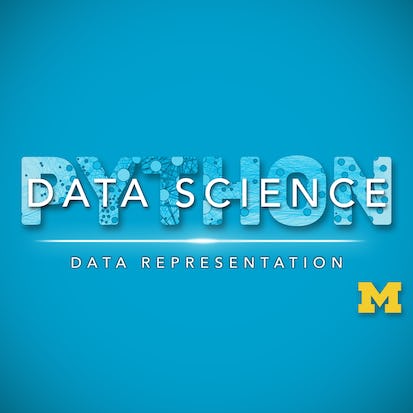- Level Professional
- Duration 24 hours
- Course by University of Michigan
-
Offered by

About
This course will introduce the learner to information visualization basics, with a focus on reporting and charting using the matplotlib library. The course will start with a design and information literacy perspective, touching on what makes a good and bad visualization, and what statistical measures translate into in terms of visualizations. The second week will focus on the technology used to make visualizations in python, matplotlib, and introduce users to best practices when creating basic charts and how to realize design decisions in the framework. The third week will be a tutorial of functionality available in matplotlib, and demonstrate a variety of basic statistical charts helping learners to identify when a particular method is good for a particular problem. The course will end with a discussion of other forms of structuring and visualizing data. This course should be taken after Introduction to Data Science in Python and before the remainder of the Applied Data Science with Python courses: Applied Machine Learning in Python, Applied Text Mining in Python, and Applied Social Network Analysis in Python.Modules
Principles of Information Visualization
1
External Tool
- Hands-on Visualization Wheel
1
Discussions
- Must a visual be enlightening?
8
Videos
- Introduction
- Updates
- About the Professor: Christopher Brooks
- Tools for Thinking about Design (Alberto Cairo)
- Graphical heuristics: Data-ink ratio (Edward Tufte)
- Graphical heuristics: Chart junk (Edward Tufte)
- Graphical heuristics: Lie Factor and Spark Lines (Edward Tufte)
- The Truthful Art (Alberto Cairo)
5
Readings
- Syllabus
- Help us learn more about you!
- Notice for Coursera Learners: Assignment Submission
- Dark Horse Analytics (Optional)
- Useful Junk?: The Effects of Visual Embellishment on Comprehension and Memorability of Charts
Assignment 1
1
Peer Review
- Graphics Lies, Misleading Visuals
1
Readings
- Graphics Lies, Misleading Visuals
Module 2: Basic Charting
1
Labs
- Module 2 Jupyter Notebooks
7
Videos
- Introduction
- Matplotlib Architecture
- Basic Plotting with Matplotlib
- Scatterplots
- Line Plots
- Bar Charts
- Dejunkifying a Plot
2
Readings
- Matplotlib
- Ten Simple Rules for Better Figures
Assignment 2
1
Peer Review
- Plotting Weather Patterns
1
Labs
- Plotting Weather Patterns
Module 3: Charting Fundamentals
1
Labs
- Module 3 Jupyter Notebooks
6
Videos
- Subplots
- Histograms
- Box Plots
- Heatmaps
- Animation
- Widget Demonstration
1
Readings
- Selecting the Number of Bins in a Histogram: A Decision Theoretic Approach (Optional)
Practice Assignment
1
Peer Review
- Practice Assignment: Understanding Distributions Through Sampling
1
Labs
- Practice Assignment: Understanding Distributions Through Sampling
Assignment 3
1
Peer Review
- Building a Custom Visualization
1
Labs
- Building a Custom Visualization
2
Readings
- Assignment Reading
- Understanding Error Bars
Module 4: Applied Visualizations
1
Labs
- Module 4 Jupyter Notebooks
3
Videos
- Plotting with Pandas
- Seaborn
- Mapping and Geographic Investigation
1
Readings
- Spurious Correlations
Project
1
Peer Review
- Becoming an Independent Data Scientist
1
Labs
- Project Description
1
Videos
- Becoming an Independent Data Scientist
2
Readings
- Post-course Survey
- 5 reasons to keep going
Auto Summary
Explore the essentials of data visualization in "Applied Plotting, Charting & Data Representation in Python," a professional-level course by Coursera in the Data Science & AI domain. Led by expert instructors, this 4-week course delves into creating effective visualizations using the matplotlib library. Ideal for those with foundational Python knowledge, it covers design principles, best practices, and advanced charting techniques. Subscription options include Starter, Professional, and Paid plans, making it accessible for a range of learners aiming to enhance their data representation skills.

Christopher Brooks


